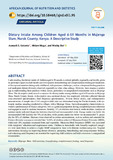Dietary Intake Among Children Aged 6-59 Months in Majengo Slum, Narok County, Kenya: A Descriptive Study

View/
Date
2024-11Author
Kotonto, Asenath S.
Muga, Miriam
Bor, Wesley
Metadata
Show full item recordAbstract
Understanding the dietary intake of children aged 6-59 months is critical globally, regionally, and locally, given
its profound impact on child health and development. Breastfeeding and complementary feeding are fundamental for optimal nutrition during early childhood, with persistent challenges, such as suboptimal feeding practices
and inadequate dietary diversity, observed, especially in urban slum settings. However, there remains a notable
gap in understanding these practices within Kenya, particularly in marginalized communities such as Majengo
Slum. This descriptive study aimed to examine the dietary intake among children aged 6-59 months in Majengo
Slum, Narok County, Kenya. A descriptive cross-sectional design was employed, with data collected through
semi-structured questionnaires, food frequency questionnaires, 24-hour dietary recalls, and anthropometric
measurements. A sample size of 341 caregiver-child pairs was determined using the Fischer formula, with systematic random sampling conducted in villages within Majengo Slums. Socio-demographic characteristics revealed a predominance of female caregivers, with a significant proportion having completed primary education
and engaged in small to medium businesses. Notably, 71% of children were born at health facilities. Analysis of
nutrient intake indicated disparities between observed and recommended levels. Energy intake was below the
recommended 1600 kcal/day for 74% of children, while protein intake was below the recommended 71 grams/
day for 89% of children. Excesses were observed in certain micronutrients, such as sodium and saturated fat.
Dietary diversity assessment revealed that 76.86% of children achieved Minimum Dietary Diversity (MDD),
while only 20% regularly consumed fruits and vegetables. Minimum Meal Frequency (MMF) was associated
with caregivers’ education and employment status. Children in households with formally employed caregivers were more likely to achieve a higher MMF compared to those with illiterate mothers/caregivers. Targeted
interventions focusing on improving dietary diversity, promoting breastfeeding and complementary feeding,
and enhancing meal frequency are essential for improving child nutrition and health outcomes in marginalized
communities.
